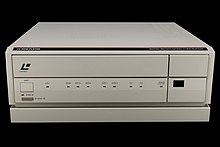LV-ROM
| Media type | analog video (per side) |
|---|---|
| Read mechanism | Laser diode |
| Developed by | Philips |
| Dimensions | 30 cm (11.81 in) |
| Usage | Interactive media |
| Extended from | Laserdisc |
| Extended to | LD-ROM |
| Optical discs |
|---|

LV-ROM is an
computer software for interactive multimedia. The LV-ROM is a specialized variation of the CAV Laserdisc
. LV-ROM is an initialism for "LaserVision Read-Only Memory".
Like Laserdisc, LV-ROM discs store
digital information, or up to 54,000 frames of analog video[1] (36 minutes with a frame rate
of 25 fps) per side.
The format had only one application: to publish documentary video, children's writings, and other historical records compiled from 1984 to 1986 for the
SCSI-1[2] to a Philips AIV VP415 Laserdisc player.[1] A genlock enabled the software stored on the LV-ROM to display computer graphics over the analog video on the BBC Master's computer screen. The buttons and menus of the user interface were accessed with a trackball. The Philips VP415 was shown in the 1989 James Bond film: “License to Kill
”.
LD-ROM
In the early 1990s,
.LD-ROMs owe their greater capacity to a design for constant linear velocity (CLV) playback. Like magnetic tape, the playback speed corresponds with picture quality and audio definition of analog audio-video streams. Since Pioneer intended LD-ROMs primarily for computer software, they chose CLV technology to increase the file storage capacity.
Specialized LD-ROM discs include the MEGA LD (for
PC-Engine CD-ROM²
software). Such software was published either on 30-centimeter discs or on 20-centimeter discs with a lesser storage capacity.
Whereas LV-ROM is an abbreviation of "LaserVision
Read-Only Memory
", LD-ROM is an abbreviation of "LaserDisc Read-Only Memory".
References
- ^ a b Rhind, David; Openshaw, Stan (1986). "The BBC Domesday System: A Nationwide CIS FOR $4448" (PDF). Archived from the original (PDF) on 15 March 2016. Retrieved 13 April 2013.
{{cite journal}}: Cite journal requires|journal=(help) - ^ The BBC Master, introduced by Acorn Computers in 1986, was one of the first home computers to feature the new SCSI-1 parallel communications bus.
See also
- BBC Domesday Project
- Edutainment
- Optical disc drive
- Pioneer LaserActive
